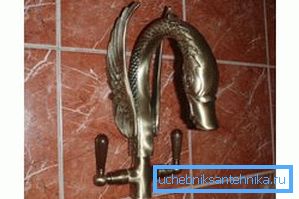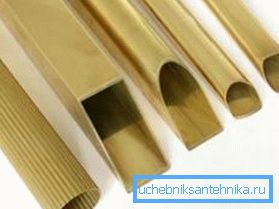Brass tube - what is the secret of popularity
The pipeline in the house should be not only reliable and durable, but preferably still stylish and beautiful. These criteria are fully consistent with such proven material as brass. There is a huge range of brands on the market now, but L63 brass pipe is best suited for plumbing purposes.

General characteristics
The first mention of this material dates back to the times of the Romans and Sumerian civilization. Although zinc, as such, was isolated only in the 16th century, and it began to be produced on an industrial scale only at the end of the 19th century. But the Romans and the Sumerians made an alloy of copper with some mineral galmee, which in reality is zinc ore.
Brass pipes for plumbing are much better suited than copper ones. Possessing good elasticity, they are much stronger and more durable than copper. In the old Europe, to this day, they continue to install pipe layouts from this alloy, this is deservedly considered to be a sign of thriftiness and good taste.
Tip: if you want to recreate in your home the classic English atmosphere of the early 20th century, then all the plumbing and wiring is better to make brass. In extreme cases, copper, but copper is less durable, plus it quickly loses its luster and darkens.

What is the alloy
From school textbooks, we know that brass is an alloy of copper and zinc. This is certainly true, but science does not stand still and now this group combines not only the so-called simple alloys, consisting of 2 components, but also a whole family of special materials. The composition, which includes a wide range of different metals and mineral additives.
Simple alloys have in their labeling one letter “L” and a digital value, which indicates how many percent of copper is in this brand. It does not make sense to denote zinc content, since by default it is considered that it occupies the rest of the volume. For example, in L63, the percentage of copper and zinc will be 63% copper and 37% zinc. These alloys are also called two-component.

Special alloys except for two classical components contain certain alloying additives and additives. The designation here is more complicated, the labeling of the additive is added to the letter component, the percentage presence of this additive is added to the numerical value. For example, the composition of LS59 1 contains about 59% copper, plus 1% is lead, the rest is 40% zinc.
There are brass, deformable and compositions that are more suitable for casting. GOST 494-90, according to which all similar products are classified, prescribes to use for the production of pipe products, exclusively deformable marks.

Brass thick-walled pipe, as well as thin-walled products, plus the vast majority of fittings for installation are produced by cold rolling, pressing or extrusion. In particular, LS59 1, in view of its strength, is more suitable for pressing. Pipes from L69 or L68, produced in a cold-rolled way.
The main differences of products from L63 and other alloys
As mentioned earlier, these two alloys are widely used in the production of sewage pipes, fittings and other plumbing products.
We give the opinion of experts about the most frequently asked questions.

- Brass pipes for water pipes of both brands have the same conductivity.
- In terms of machining, in particular, cutting and planing pipes from LS59 1 are easier to grind and cut, forming fine chips. L63 in this indicator, of course, is inferior to the previous mark, but not by much. It is caused by the fact that lead imparts rigidity, and the cutter is less bogged down in the metal.
- But not everywhere the increased strength of the LS59 1 is in demand.. The presence of lead increases the fragility of the product and with a strong angular load, the presence of a notch or defect such a pipe may burst. L63, in turn, has a higher elasticity and, as a maximum, it will bend a little. In metallurgy, there is a measure of toughness, and so, for L63 it is 14, versus 5 - 6 for LS59 1.

- The brass thick-walled alloy pipe LS59 1 has a higher strength, therefore, can withstand increased pressure in the system. Plus fittings for sewer systems and all sorts of connecting elements made of this composition are considered more reliable and durable.
- From a purely practical point of view, if you are going to bend the plumbing route with your own hands, giving it your own individual forms, then experts advise you to take pipes from L63.
Subtleties of installation
Brass pipes for water supply can be mounted in two ways, by threaded connections using fittings and various kinds of nuts or soldering. If you are a beginner and are going to mount the system yourself, then it will be more convenient for you to use the threaded version, since soldering requires special equipment and certain professional knowledge and skills.

The installation of any pipeline is inevitably accompanied by a small loss of material during cutting and fine adjustment. Therefore, no matter how exactly you draw the route plan, it is better to take the material with a margin.
The installation instructions for brass pipes are mirror-like to the installation technology for copper or steel products. The pipe is cut with a hacksaw for metal or a grinder, then a chamfer is removed by a file and the burrs are removed. If necessary, a thread is cut or a compression ring with a nut is used. For the connection density, a fum tape is necessarily used; it is wound clockwise.
As a rule, such a beautiful, radiant pipe layout, the price of which is impressive, they prefer not to hide in the walls. The trading network now has a huge selection of different decorated brass fixtures for external mounting of the brass pipeline.

Tip: when selecting a material, you may encounter a profile tube, it can be square or rectangular. These pipes are widely used in electrical engineering, theoretically one can install a stylish plumbing, but in this case it is better to invite professionals.
On the video in this article it is fashionable to see some trivia on the subject of brass products.

Conclusion
I would also like to note that not all brass pipes are intended for arranging water supply. For example, a brass pipe of 14x1 mm, although produced by the brand L63, but intended for use in various technical units. In the water supply of an apartment, a cross section of 14 mm can be used except for the supply of taps or for arranging a heated floor.
